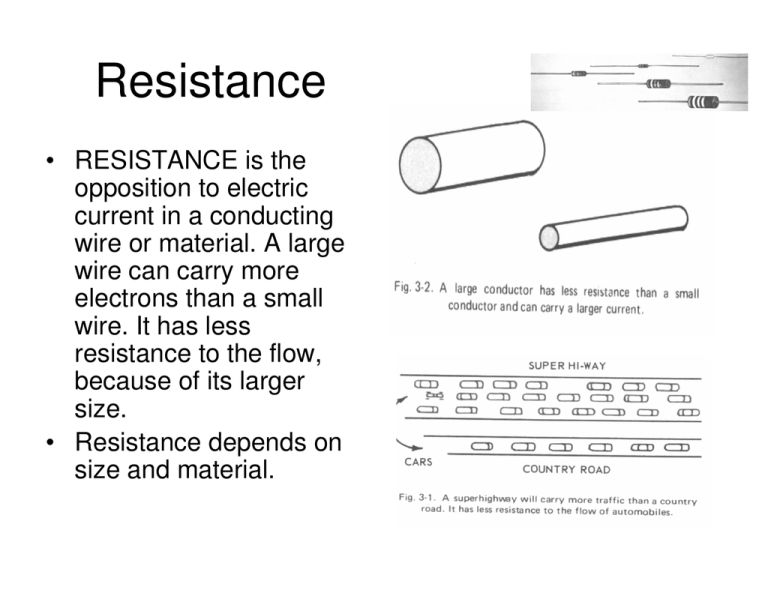Resistance
advertisement

Resistance • RESISTANCE is the opposition to electric current in a conducting wire or material. A large wire can carry more electrons than a small wire. It has less resistance to the flow, because of its larger size. • Resistance depends on size and material. Current • • • Current is the rate of charge movement A current exists whenever there is a net movement of electric charge through a medium. To define current more precisely, suppose positive charges are moving through a wire. The current is the rate at which these charges move through the cross section of the wire. If ∆Q is the amount of charge that passes through this area in a time interval, ∆t, then the current, I, is the ratio of the amount of charge to the time interval. Current can be direct or alternating There are two different types of current: direct current (dc) and alternating current (ac). In direct current, charges move in only one direction. In alternating current, the motion of charges continuously changes in the forward and reverse directions. In alternating current, the terminals of the source of potential difference are constantly changing sign. Hence, there is no net motion of the charge carriers in alternating current; they simply vibrate back and forth. Ohms Law OHM’S LAW One of the fundamental laws of electrical circuits was derived from experimentation done by George Simon Ohm, the German scientist and philosopher, during the 19th century. To honor the achievements of Mr. Ohm, the standard unit of measurement for resistance is called the OHM. It is frequently represented by the Greek letter “omega” as . If you see on a diagram 1000 c , it means 1000 ohms. In electronic circuits Using Ohms Law Series Circuits • SERIES CIRCUITS • If a circuit is so arranged that all of the current flowing in the circuit will pass through all components, these components are connected in SERIES. • As current passes through a resistor, a certain amount of energy is used and a certain amount of pressure or voltage is lost. The voltage loss across each resistor may be calculated by Ohm’s Law, using formula, E(V) = I x R, Series Circuits…. Kirchhoff’s Laws • Since these resistors are connected in series, all the current flowing in the circuit must pass through each resistor. Therefore, current is the same in all parts of the circuit. • 1. The sum of the voltage drops around a series circuit will equal the source voltage. • 2. The current is the same when measured at any point in the series circuit. • Parallel Circuits Current When several components are When equal resistors are connected in parallel, the total resistance of the parallel network is equal to any one resistor divided by the number of resistors in the network. connected to the same voltage source, the components are connected in parallel or “side by side.” Multiple paths for current flow are provided by a parallel circuit, because each resistor constitutes a path of its own. The applied voltage is the same for each resistor, because each is connected across the same voltage source. Therefore, the currents are, using Ohm’s The total current flowing through the network would be the sum of the individual branch currents or: .2 + .2 + .2 = .6 amps Multiple resistors with different values. • The conductance of a circuit is equal to the sum of the conductances of the branch circuits. • Sum the 1/R of the resistances and then recipicate the answer. Parallel Circuits Resistance… Parallel Circuits… Summarizing • The voltage across all branches of a parallel network is the same. • The total current is equal to the sum of the individual branch currents. • The total resistance of any parallel circuit must always be less than the value of’ any resistor in the network.. • The branch of the circuit containing the greatest resistance conducts the least current.






